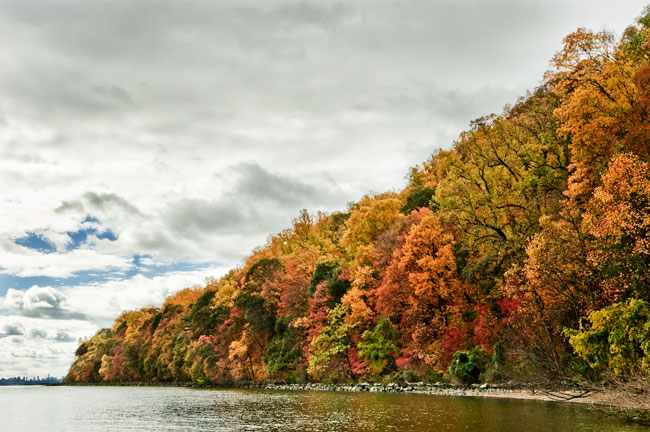Requiem for a Nut
A “Cliff Notes” Story
October 1998
“With Blue Sky Above and the majestic Hudson Below … A glorious confusion of color — yellow and orange, scarlet and crimson, intermingled with the eternal green of the hemlock and fir — and above all, a line of perpendicular gray cliffs, standing out against a deep blue sky! Thus at this season of the year appear the Palisades, robed in the glory of Autumnal foliage, while the majestic Hudson — a dreamy haze hanging over its bosom — flows silently past their base on its way to the sea…”

So wrote the New York Recorder in October, 1893. And while we may find the prose a bit overblown, the description still strikes us as quite apt of this most enchanting time of year, when our tall cliffs and their tenacious forests never seem more wildly picturesque.
It may be tempting, then, to suppose that here, at least, a piece of New Jersey’s woodlands has been preserved as it has stood for centuries untold, a sliver of the Forest Primeval just as Henry Hudson came upon in 1609. Tempting — but extravagantly unrealistic. For in truth the forest world is a dynamic one, and even in those places we assume to be relatively “pristine,” dramatic changes have occurred over the centuries — changes now vastly accelerated by human activity.
No tale, we feel, brings this truth closer to home than that of the American chestnut, Castanea dentata.
At the time of Hudson’s visit, this cousin of the oak was in all likelihood the dominant tree of the Palisades — as it was for much of the Eastern Seaboard, thriving in acid upland soils from New England to Alabama. (In the Appalachian Mountains, it is believed that as many as one in every four trees was an American chestnut.) The chestnut was a blessing to the settlers who followed Hudson, its delicious nuts soon a dietary staple. Its bark was stripped and used for roofing. Boards hewn from its straight trunks and limbs were found to season well and take to gluing and nailing without warping or shrinking. A fast growing tree — one of the reasons it was so successful — it could be harvested with little threat of being wiped out. Hard and lightweight, it was easily worked, with the finished product taking a high polish, making it a favorite for furniture stock, while its graceful form shaded innumerable courthouse lawns. Perhaps best of all, its wood was famously resistant to rot, ideal for fence posts and, later, railroad ties. By the mid-nineteenth century, it had become one of the most important trees economically in North America. (Besides its other virtues, its bark and wood were rich in tannic acid, essential for leather-making, and the chestnut became a mainstay of the American leather industry. Wood pulp, a by-product of tannin extraction, made it a mainstay of the burgeoning paper industry as well, resulting in an often complex, interdependent relationship between the two industries.)
And none of this even hints at C. dentata’s ecological importance to our native forests. In this ancient world, the fast growing, resilient tree with its nutritious fruit was no less a mainstay, in many ways defining the forests in which it grew. (The term “chestnut-oak forest” gets repeated time and again in the descriptions written by naturalists of a century ago.) To say this tree was an integral part of the forest habitat here in the East is, surely, grossly to understate matters.
No wonder, then, that around 1904 and starting here in the New York region, not even professional naturalists seemed to recognize how momentous a tragedy was underway, as the first chestnut trees began to die.

A forester named Herman W. Merkel noticed something wrong with the chestnuts on the grounds of the Bronx Zoo in that year. Cankers had formed on their trunks, encircling them. The cankers were soon to kill the trees above the point of infection. Mycologists in the New York Botanical Garden identified the culprit as a previously unknown fungus, to which they gave the name Endothia parasitica. Still, E. parasitica was at that point seen as an interesting but relatively unimportant event, a topic for specialists to discuss. Even as the blight spread into neighboring states, scientists were slow to recognize the potential enormity of the disaster, and it was not until 1911 that funds were first appropriated — $5,000 by the U.S. Congress — to combat the problem.
By then trees in Philadelphia had begun to die.
The following year Congress upped its appropriation to $80,000, and in 1913 the Pennsylvania legislature would itself weigh in with an appropriation of $240,000 and the creation of a Chestnut Tree Blight Commission. This was an impressive outlay in the dollars of the time, and a strong course of action for a state to take on behalf of a tree.
Unfortunately, it was already too late.
That same year, botanists working in China found the blight on chestnut trees “9 days by bullock cart northeast of Peking.” This seemed to confirm what the Blight Commission had come already to suspect, that the disease had originated in Asia, most likely arriving in New York Harbor with a shipment of nursery stock from China. But how had it spread so quickly? Certainly, its spores could be carried by the wind, perhaps as far as half a mile on a dry, gusty day. Yet that could hardly account for its spread across hundreds of miles in a few short years.
E. parasitica, it turned out, had two kinds of spores, the smaller of these having the more effective mode of travel. These had thin, gelatinous threads attached to them, and they stuck by the thousands to the feet of birds. (As many as seven thousand were counted on the feet of a single woodpecker.) At last the sobering magnitude of the disaster became apparent: not a single chestnut tree in North America could be considered safe.
By the end of the World War I, the North American “chestnut-oak forest” was a standing graveyard, the dead trunks, in a macabre testament to their famed tenacity, still upright, their wood to be harvested for decades to come. (Much of the wood in the structures built by the New Deal agencies during the 1930s here in the park was chestnut taken from the standing dead on the Palisades.) Fence posts and railroad ties, some cut a century or more ago, are still sought by craftsmen and builders to this day.
Here on the Palisades, a handful of adult chestnut trees still survive (a large specimen only succumbed in Greenbrook Sanctuary about five years ago). Sadly, their fruit remains infertile. Saplings sometimes spring from the stumps of former giants; almost invariably, they soon contract the blight and die.
Extinction is, as they say, as old as the hills. And if, as they also say, there are a million stories in the naked city, then there may be a million more in the leaf-clad world of the forest, where life and death and change are the endless norms. The forest habitat has always been a dynamic one — only the pace has picked up some in recent centuries. The story of the American chestnut is a particularly dramatic example of an ongoing theme in our modern world, as we bring the four corners of the globe into ever closer contact. (The “eternal green” of our hemlock groves has also begun to whither and fade in recent years, another blight brought to this continent from afar.) And as in the case of “natural” extinction, of course, new species are always ready to fill the proverbial vacuum so abhorred by nature.
Certainly, we don’t mean to put a damper on anyone’s enjoyment of fall, a time of year when we tend to notice trees more than at any other—for in the appreciation of nature may begin the road to its preservation. Nor do we offer any handy, pat solutions for the kinds of issues raised by the tale of the chestnut. But as stewards of a “natural” preserve, neither can we safely ignore such tales, as they continue to have a direct bearing on the land in our care. Certain tales of the forest, we feel — even sad ones — should be told.
– Eric Nelsen –

